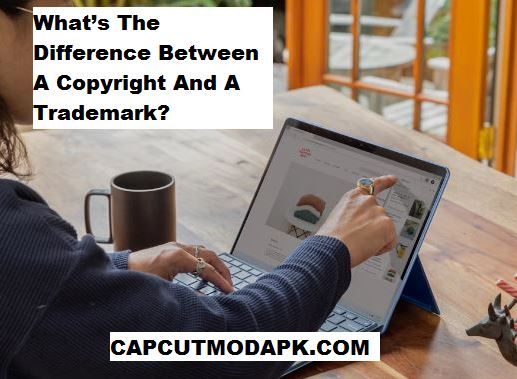When you create something original, whether it’s a logo, a song, or a product name, you want to make sure that no one else can steal your hard work. The legal protections available to you are copyrights and trademarks. But many people get confused when trying to figure out What’s The Difference Between A Copyright And A Trademark? While both protect intellectual property, they serve different purposes and apply to different types of creations. Understanding these differences is crucial for anyone who creates or owns intellectual property.
Copyrights and trademarks are two distinct ways of protecting your ideas, but they overlap in certain areas. A copyright protects original works of authorship like music, books, and art, while a trademark protects logos, brand names, and slogans. If you’re trying to decide whether to apply for a copyright or a trademark, it’s essential to know the nuances of each. The distinction between the two can sometimes be tricky, and choosing the right one will depend on what kind of intellectual property you’re dealing with.
In this article, we will explore the key differences between a copyright and a trademark, answer common questions, and help you decide which one is best for protecting your work. So, let’s dive into What’s The Difference Between A Copyright And A Trademark? and get a clear understanding of each.
Is It Better to Trademark or Copyright a Name?
When deciding whether to trademark or copyright a name, it’s important to know the specific purpose of each type of protection. In general, What’s The Difference Between A Copyright And A Trademark? can be explained by understanding that a trademark protects a name used in commerce to identify the source of goods or services, while a copyright protects original works of authorship like literary or artistic works.
If you have a brand name or business name that you want to protect, it’s best to trademark it. Trademarks help prevent others from using a similar name for their own products or services, ensuring that your customers can easily distinguish your brand from others in the marketplace. Trademarks are intended for names, logos, and other identifiers that distinguish your brand from competitors.
Copyrights, on the other hand, cannot be used to protect a name. Copyrights protect creative expressions such as books, songs, films, and artwork. While the name of a book or a film can’t be copyrighted, the content within it, such as the text, images, or music, can be. If you’re looking to protect a name, particularly for a brand or product, a trademark is your best bet.
Do I Copyright or Trademark a Logo?
A logo is one of the most important elements of your brand identity, and knowing What’s The Difference Between A Copyright And A Trademark? will help you determine the best way to protect it. While copyrights and trademarks both offer legal protection for creative work, they serve different purposes.
A logo can be protected by both copyright and trademark law, but the protection you choose depends on how the logo is used. Copyright protection automatically applies when a logo is created, as long as it is original and fixed in a tangible medium. This means that the artistic elements of the logo, such as the design, colors, and illustrations, are protected as copyrighted works. Copyright, however, does not protect the name or commercial use of the logo.
If you want to protect your logo’s commercial use and prevent others from using a similar design to represent their business or product, then trademark protection is necessary. Trademarks protect the name, logo, and other identifiers that distinguish your business in the marketplace. Registering a trademark for your logo ensures that no one else can legally use a similar logo to confuse your customers or profit off your brand’s reputation.
In summary, while copyright protects the artistic work behind the logo, trademark protection ensures that your logo functions as a source identifier for your business. You may want to apply for both copyright and trademark protection to fully secure your logo.
What Cannot Be Copyrighted or Trademarked?
When you’re deciding whether to copyright or trademark something, it’s important to know What’s The Difference Between A Copyright And A Trademark?, and also what can and can’t be protected. Both copyright and trademark law have restrictions on what can be protected.
In general, you cannot copyright ideas, methods, or systems. For example, you can’t copyright a business process or a scientific principle. Copyright also doesn’t protect names, titles, or short phrases. So, if you have a catchy slogan or a single word you want to protect, a trademark is the right option for you, not a copyright. Trademarks are specifically designed to protect these types of identifiers.
There are also certain things that cannot be trademarked. For example, generic or descriptive words that don’t distinguish your product from others cannot be trademarked. For instance, you cannot trademark the word “apple” for a tech company because it is too common and descriptive. Trademarks are intended to distinguish the source of goods or services, so they must be unique and not too similar to existing trademarks in the same category.
Understanding these limitations will help you decide which legal protections are right for your intellectual property.
Does Copyright Override a Trademark?
The question of whether copyright overrides a trademark is one that comes up often when people are trying to figure out What’s The Difference Between A Copyright And A Trademark? The answer depends on the specific situation and the type of intellectual property at issue.
In general, copyright and trademark laws operate independently of each other. This means that a copyright does not override a trademark, and vice versa. The two protections serve different purposes. A copyright protects creative works like music, art, and literature, while a trademark protects brand names, logos, and slogans used in commerce. If you have both a copyright and a trademark for the same piece of work, each will provide separate protection for different aspects.
For example, if you have a book that features a unique character or story (which is copyrighted), and you also use the name of that character as your brand or logo in business (which can be trademarked), both protections can coexist. Copyright protects the artistic elements of the character, while the trademark protects the brand identity of the character. One doesn’t override the other; they work in tandem to protect different aspects of the intellectual property.
In short, copyright and trademark protections are separate and apply to different areas of intellectual property. You need both protections if you want comprehensive legal coverage for your work.
How Much Does a Trademark Cost?

If you’re considering registering a trademark, you’re likely wondering What’s The Difference Between A Copyright And A Trademark? in terms of cost. The cost of registering a trademark varies depending on several factors, including the type of application, the number of classes of goods or services, and whether you’re hiring a lawyer to assist you.
On average, the cost to file a trademark application with the United States Patent and Trademark Office (USPTO) ranges from $250 to $350 per class of goods or services. You can file an application online through the USPTO’s website, and the process typically takes several months. If you choose to hire an attorney to help with your application, legal fees can add anywhere from $500 to $2,000 or more.
While the initial filing fee may seem high, the protection that a trademark offers is valuable in the long run. Trademarks are valid for 10 years, and they can be renewed indefinitely as long as the mark is still in use. If you have a business or brand name that you want to protect, investing in a trademark is a smart decision.
What Cannot Be Used as a Trademark?
When considering What’s The Difference Between A Copyright And A Trademark? it’s essential to know that not every word or logo can be used as a trademark. To be eligible for trademark protection, your mark must meet specific criteria.
A trademark must be distinctive, meaning it must set your goods or services apart from others. Generic or descriptive terms that simply describe your product or service cannot be trademarked. For example, “Best Pizza” would not be eligible for trademark protection because it simply describes the product. Similarly, if your logo looks too similar to an existing trademark, it will be rejected.
Additionally, certain symbols or designs cannot be trademarked, such as those that are offensive, immoral, or deceptive. Trademarks that are too similar to existing government insignias, national flags, or names of famous people may also be prohibited.
It’s crucial to conduct a thorough search of existing trademarks before applying to avoid infringing on someone else’s rights and to increase your chances of a successful application.
Conclusion
In conclusion, What’s The Difference Between A Copyright And A Trademark? can be summed up by recognizing that copyright protects creative works like books, music, and art, while trademarks protect names, logos, and branding elements. While there are some overlaps in protection, each offers distinct legal safeguards depending on the type of intellectual property in question.
Understanding whether to copyright or trademark your work can save you time and money in the long run. By knowing what each type of protection covers, you can make an informed decision about how to protect your ideas, brand, or creative works. Whether you’re creating a new logo or launching a business, knowing What’s The Difference Between A Copyright And A Trademark? ensures that your intellectual property is legally safeguarded.


